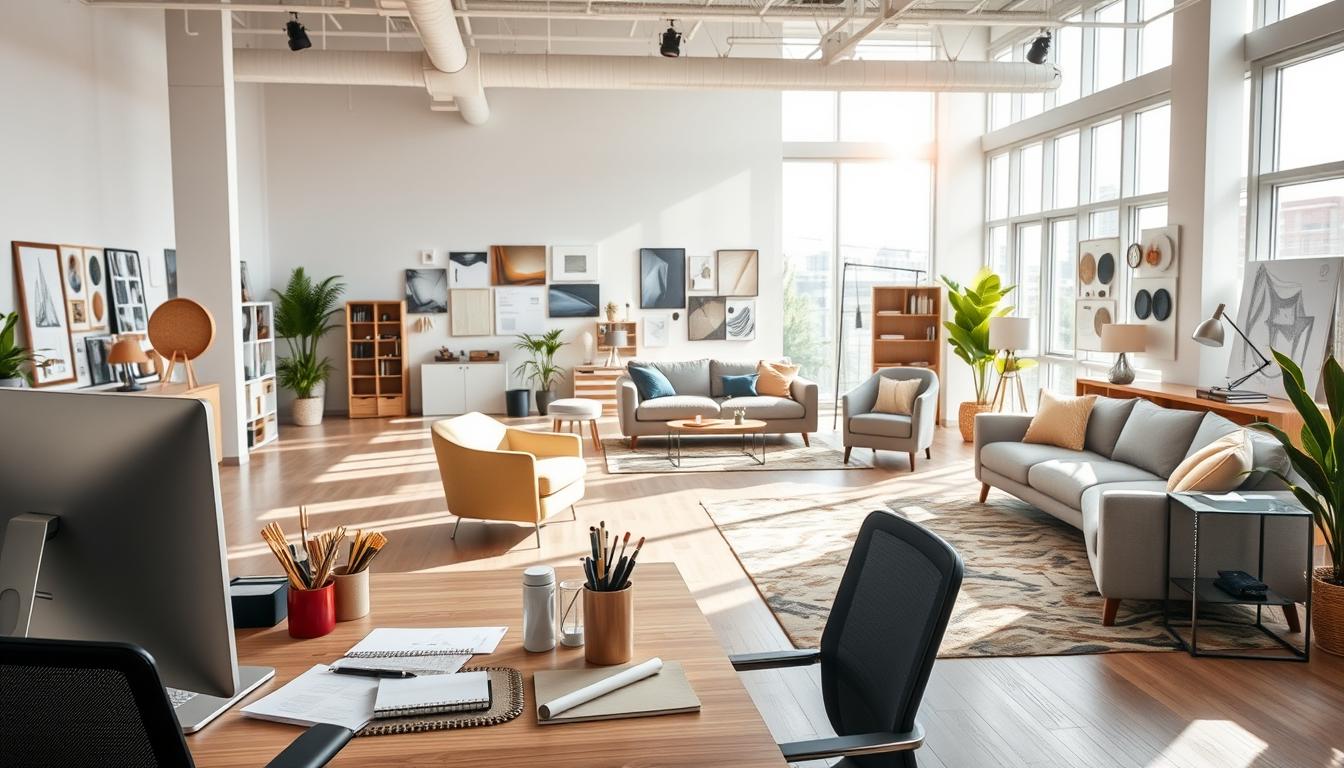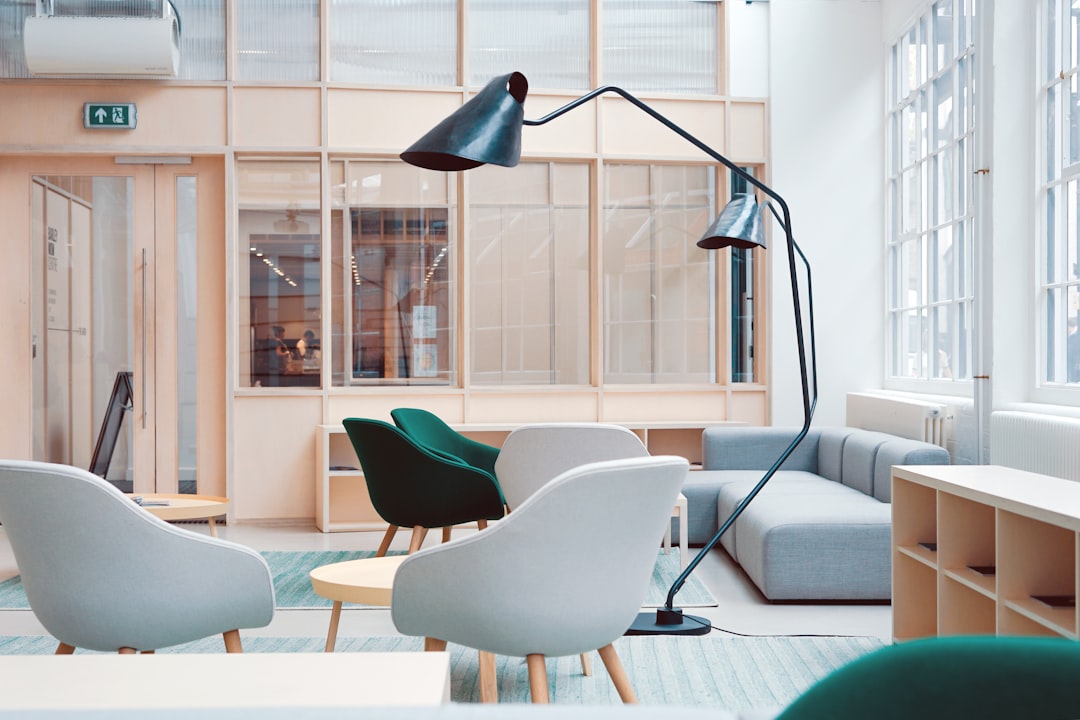The world of interior design is full of possibilities. It offers many career paths for those who love to be creative. With the industry growing fast, now is a great time to look into interior design career opportunities.
Exploring interior designer jobs means understanding the different roles and skills needed. You’ll work on everything from homes to offices. It requires creativity, technical skills, and a focus on details.
We’ll help you through the exciting world of interior design. We’ll cover the main tasks, important skills, and different interior design jobs. This will guide you to your perfect career.
Key Takeaways
- Understanding the diverse roles within the interior design industry.
- Identifying key skills required for success in interior design careers.
- Exploring various types of interior design jobs and their average salaries.
- Learning about the qualifications and certifications needed for interior design jobs.
- Navigating the process of finding your dream career in interior design.
Understanding the Role of an Interior Designer
To succeed in interior design, it’s key to know the designer’s role. They do more than make spaces look good. They also make sure designs are functional, safe, and meet user needs.
Key Responsibilities in Interior Design
Interior designers have many tasks. They pick colors, furniture, and check if designs follow rules. They also manage projects well, staying within budgets and deadlines. Good communication with clients and others is vital.
Some of the key tasks include:
- Assessing the needs of clients and determining the requirements of a project
- Developing initial design concepts and presenting them to clients
- Selecting materials, finishes, and furniture that meet the design concept and budget
- Ensuring that designs comply with relevant laws, regulations, and standards
Essential Skills for Interior Designers
To be great at interior design, you need creativity, technical skills, and good people skills. Creativity helps come up with new ideas. Technical skills are for understanding rules and how to make designs work.
Key skills include:
- Creativity and the ability to think outside the box
- Strong communication and project management skills
- Knowledge of building codes, regulations, and industry standards
- The ability to work effectively with clients, contractors, and other professionals
Knowing what an interior designer does and what skills are needed helps prepare for a career. Whether you’re looking for jobs or want to improve your skills, understanding the role is the first step.
Types of Interior Designer Jobs Available
Interior design is a wide field with many job types. Each job fits different skills and interests. Exploring these paths can show you the many opportunities in this exciting field.
Residential Interior Designer Roles
Residential interior designers help homeowners make their homes reflect their style. They pick materials and finishes and manage the design process. If you’re thinking about this career, you might want to find local interior design services to learn more.
Commercial Interior Designer Positions
Commercial interior designers create spaces for businesses like offices and stores. They need to know about branding and how people use spaces. It’s a challenging job but very rewarding.
Some key tasks for commercial designers include:
- Doing site analyses to understand the space
- Creating design concepts that match the client’s brand
- Picking materials and finishes that are durable and green
Specialty Areas: Sustainable and Universal Design
There are also special areas in interior design. Sustainable design makes spaces eco-friendly. Universal design makes spaces accessible to everyone.
Designers in these areas can really help people and the planet. They use green materials and design for everyone, making spaces beautiful and useful.
The Importance of Education and Training
Education and training are key for success in interior design. As the field grows, a strong educational base is vital for landing good interior design positions.
To stand out in interior design job vacancies, you need the right education. A degree in Interior Design or a related field is usually necessary.
Recommended Degrees for Aspiring Designers
Aspiring interior designers should aim for a Bachelor’s degree in Interior Design or related fields like Fine Arts or Architecture. These programs cover essential design topics like color theory, spatial planning, and materials science.
The table below shows common degree programs and their focuses:
| Degree Program | Focus Areas |
|---|---|
| Bachelor’s in Interior Design | Design principles, spatial planning, color theory |
| Bachelor’s in Fine Arts | Studio arts, art history, visual theory |
| Bachelor’s in Architecture | Building design, structural systems, urban planning |
Certifications That Enhance Your Career
Certain certifications can boost a designer’s career. The National Council for Interior Design Qualification (NCIDQ) certification is highly valued.
Getting these certifications shows your expertise and dedication to your craft. It makes you more appealing for interior design job vacancies.
By focusing on education and getting relevant certifications, aspiring designers can succeed in the competitive interior design job market.
Building a Strong Portfolio as a Designer
A well-crafted portfolio is key for a successful interior design career. It shows your skills and creativity to potential employers. As you start in careers in interior design, it’s crucial to have a portfolio that showcases your best work.
What to Include in Your Portfolio
Your portfolio should only include your best work. Show a variety of projects to prove your range and expertise. For interior designer jobs, include residential, commercial, and specialty projects like sustainable design.
Case studies are also important. They explain your design choices and problem-solving skills. When adding a project, think about the story behind it and how it shows your abilities.
- Highlight your role in each project, especially if you worked as part of a team.
- Include before-and-after photos to demonstrate the impact of your work.
- Provide a brief description of the project’s objectives, your design process, and the outcome.
How to Present Your Work Effectively
How you present your portfolio is just as important as the content. For tips, check out The Interior Design Institute’s blog on creating interior design portfolios. A well-organized and visually appealing portfolio will make a stronger impression.
Use high-quality images and make sure your portfolio is easy to navigate. For digital portfolios, create a website or use a platform that showcases your work in an engaging way.
By focusing on building a strong portfolio, you’ll be well on your way to success in careers in interior design. You’ll also be more likely to find the interior designer jobs that fit your skills and goals.
Networking and Finding Job Opportunities
In the world of interior design, networking is key to finding jobs. It’s important to know how to use your professional connections to advance your career.
Networking isn’t just about going to events. It’s about making real connections in the industry. Social media platforms are great for meeting potential employers and showing off your work. Let’s look at how to use these platforms well.
Leveraging Social Media for Opportunities
Social media has changed how we network, offering many chances to meet industry pros. Sites like LinkedIn and Instagram are especially good for interior designers.
- Create a professional profile that shows your portfolio and skills.
- Chat with industry leaders and join in on discussions.
- Use hashtags to make your work more visible.
Being active on these platforms can really help you get noticed by employers. Here’s a quick look at how different platforms can help:
| Platform | Primary Use | Benefits for Interior Designers |
|---|---|---|
| Professional Networking | Connect with employers, join industry groups | |
| Visual Portfolio Showcase | Share your designs, engage with the design community | |
| Inspiration and Idea Sharing | Share your work, discover trends and inspirations |
Joining Professional Organizations
Joining professional groups is another great way to grow your network and keep up with trends. Groups like the American Society of Interior Designers (ASID) offer many benefits. These include networking events, learning opportunities, and access to industry publications.
Being a member of these groups can help you:
- Go to conferences and seminars to learn about new things.
- Meet experienced pros and potential employers.
- Find exclusive job listings and career tools.
Building a strong network takes time and effort. But it’s a key step to finding your dream job in interior design. By using social media and joining groups, you can boost your career chances.
The Application Process Explained
Getting a job in interior design is not just about talent. It’s about a smart application process. To stand out in the interior design employment world, you must impress from the start.
Crafting the Perfect Resume for Interior Design
Your resume is your first chance to impress employers. Make it count by focusing on your design experience and skills. Here are some tips:
- Customize your resume for each job, using keywords from the job description.
- Include a link to your portfolio or attach it to show your best work.
- Use numbers to show your achievements, like metrics or statistics.
Tips for Nailing Your Job Interview
Crushing it in the job interview is key for moving forward in the interior design job search. Being prepared is essential. Here are some tips to help you:
- Learn about the company, its design style, and current projects.
- Prepare answers to common questions, like “What inspires your designs?” or “How do you tackle project challenges?”
- Practice your answers with a friend or mentor to boost your confidence.
By following these tips and showing professionalism, you can boost your chances in the interior design job market.
Salary Expectations in the Interior Design Field
When you look at interior design job listings, knowing the salary range is key. Salaries in interior design change a lot. This depends on where you are, how long you’ve been working, and the job itself.
Many things can change how much you earn as an interior designer. It’s important to know these to have the right expectations.
Factors That Affect Interior Design Salaries
Several key factors impact salaries in the interior design field. These include:
- Location: Salaries can vary a lot based on where you are. This is because of living costs and demand for design services.
- Experience: More experienced designers get paid more. This is because they have more clients and a better portfolio.
- Industry Segment: Your salary can also change based on the type of design you do. This includes residential, commercial, or sustainable design.
- Education and Certifications: Having advanced degrees or certifications can help you earn more.
Average Salaries by Region in the U.S.
Salaries for interior designers differ a lot across the U.S. Here’s a quick look:
| Region | Average Salary Range |
|---|---|
| Northeast | $45,000 – $70,000 |
| South | $40,000 – $65,000 |
| Midwest | $42,000 – $60,000 |
| West | $50,000 – $80,000 |
Knowing these regional salary differences helps you find the right interior design positions. It also helps you set fair salary expectations based on your location and other factors.
Freelancing vs. Working for a Firm
Interior designers often face a big career choice: freelancing or working for a firm. This choice affects their career path and happiness.
Pros and Cons of Freelance Interior Design
Freelancing lets designers pick their projects and clients, leading to more rewarding work. Flexibility in scheduling helps them balance work and life. But, freelancers must handle business tasks like marketing and invoicing, which can be hard.
Freelancers also face inconsistent income and lack support from a firm. To succeed, they need to be organized and skilled in business management.
- Pros: Flexibility, autonomy, potential for higher earnings
- Cons: Inconsistent income, business management responsibilities, isolation
Benefits of Employment with Design Firms
Working for a firm brings stability and security with a steady income and benefits. It offers chances for professional growth and access to resources and a team. Designers also get support from colleagues in a structured environment.
Firms have established client bases and marketing, easing the burden of finding clients. However, designers may have less control over their projects and schedules.
- Benefits: Stability, professional growth, access to resources and team support
- Drawbacks: Less control over projects, potential for bureaucracy
The choice between freelancing and working for a firm depends on personal goals and strengths. Understanding the pros and cons helps designers make informed career decisions in the field of interior design job vacancies and careers in interior design.
Trends in the Interior Design Job Market
The interior design job market is changing fast. New trends and technologies are coming up. Interior designers need to keep up to find new interior design career opportunities.
There’s a growing need for specialized skills. This is because of changing tastes and new tech. It’s creating new jobs in the field.
Emerging Roles in Interior Design
New areas of focus are popping up. For example, sustainable design is getting more attention. It focuses on green materials and saving energy.
Universal design is another new field. It’s about making spaces that everyone can use, no matter their age or ability. These areas not only improve lives but also offer new paths for designers.

How Technology Is Transforming the Industry
Technology is changing the interior design world. Digital tools and software are becoming key. They help designers make more precise and detailed plans.
Virtual reality (VR) and augmented reality (AR) are also making a big impact. They let clients see designs before they’re built. This makes clients happier and makes the design process smoother.
Also, tech is making it easier to work from anywhere. Interior designers can now work with clients and teams all over the world. This opens up more interior designer jobs for everyone.
Continuing Education for Career Growth
In the fast-changing world of interior design, keeping up with education is key. Designers need to know the newest trends, tech, and methods to stay ahead in the interior design job search.
Workshops and Online Courses to Consider
There are many ways for interior designers to keep learning. Workshops and online courses are great for learning new skills or getting deeper into topics like green design or universal design.
- Online platforms like Udemy, Coursera, and Skillshare have lots of interior design courses.
- Groups like the American Society of Interior Designers (ASID) offer workshops and webinars on new trends.
- Local design schools and community colleges also have classes for continuing education.
The Importance of Staying Updated with Trends
Keeping up with trends is crucial for several reasons. It lets designers give their clients the latest and most appealing designs. This boosts their standing in the interior design employment field.
“The key to success in interior design is not just about creating beautiful spaces, but also about understanding the evolving needs and preferences of clients.” –
Also, knowing the latest materials, tech, and design ideas helps designers innovate and stand out.
To do this, designers can:
- Go to industry conferences and trade shows.
- Follow top design blogs and social media stars.
- Join design contests to test their skills and get inspired.
By focusing on continuing education, interior designers keep their skills sharp. This boosts their career chances and helps the whole design field grow.
Resources for Job Seekers in Interior Design
As we wrap up our look at interior designer jobs, it’s key to know where to start or grow your career. We’ve covered many parts of the interior design world. This includes the different jobs out there, the role of education, and the need for training.
Top Job Boards for Interior Design Careers
Looking for interior design jobs? Check out top job sites like Indeed, LinkedIn, and Glassdoor. They list a variety of interior design roles. You’ll find everything from home to commercial and even green design jobs.
Professional Development Opportunities
To keep up in the field, you need to keep learning and improving. Look into resources like the American Society of Interior Designers (ASID) and the National Kitchen and Bath Association (NKBA. They offer workshops, online classes, and certifications to boost your career in interior design.



